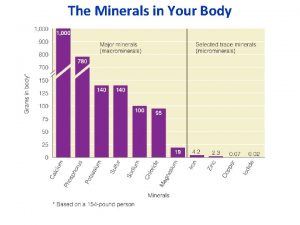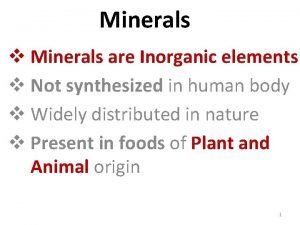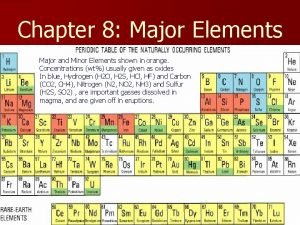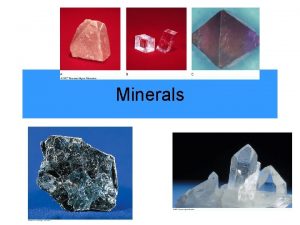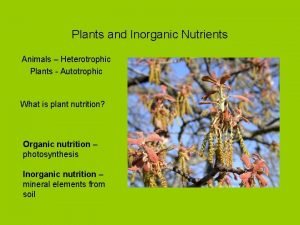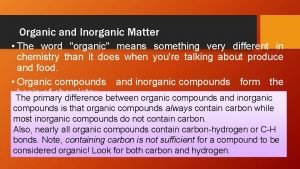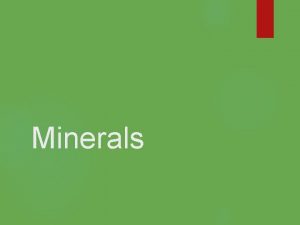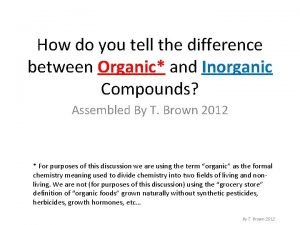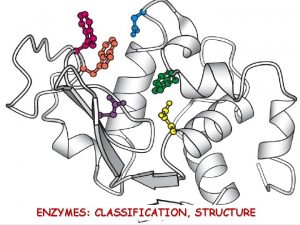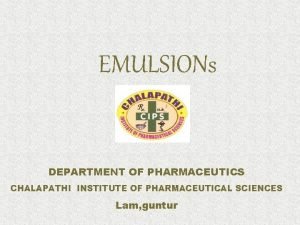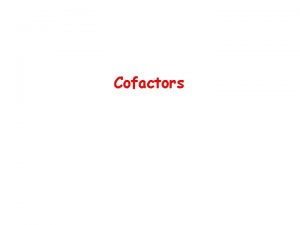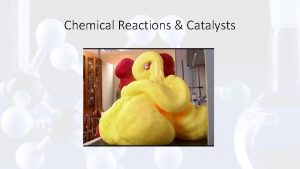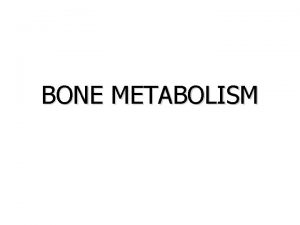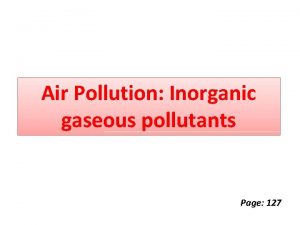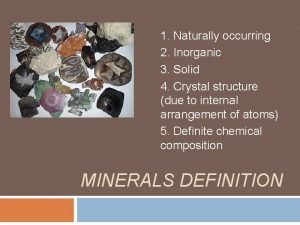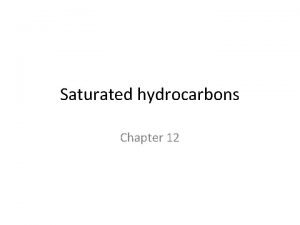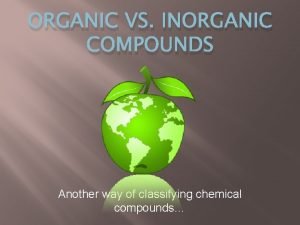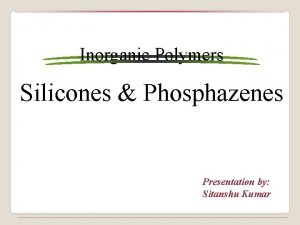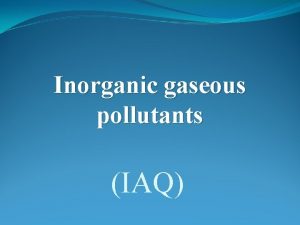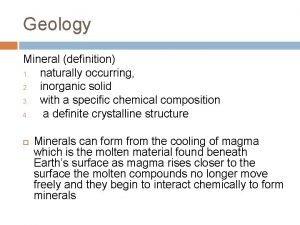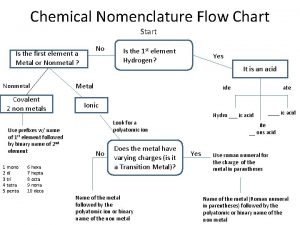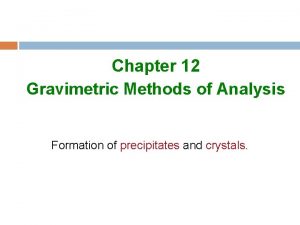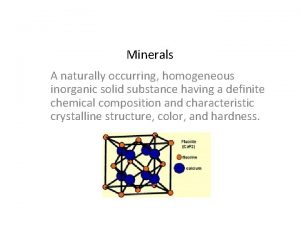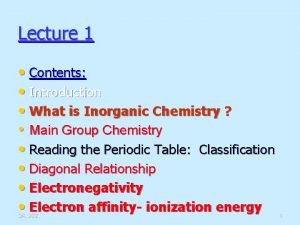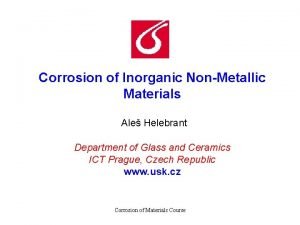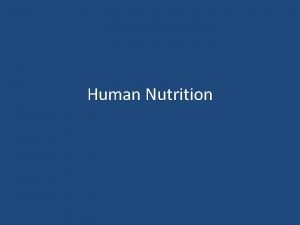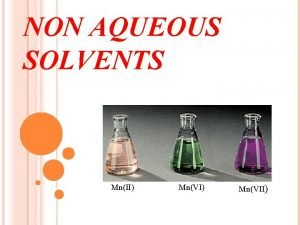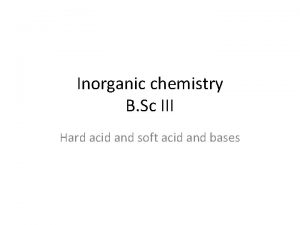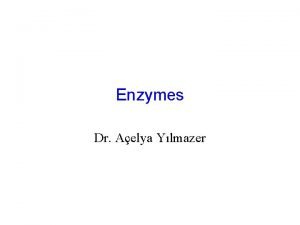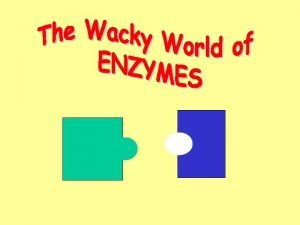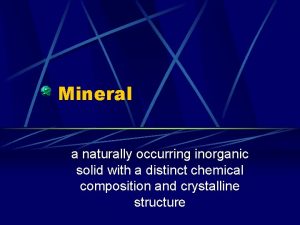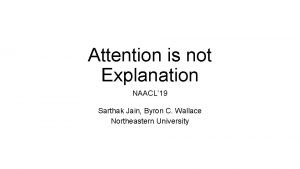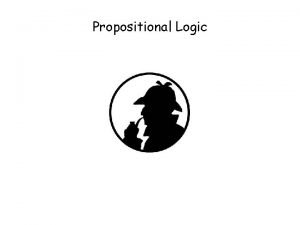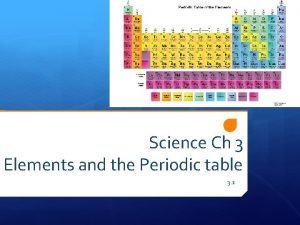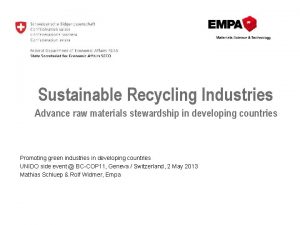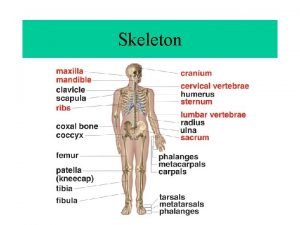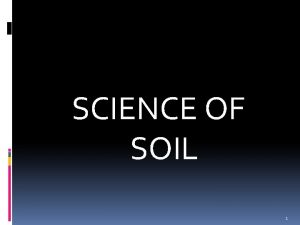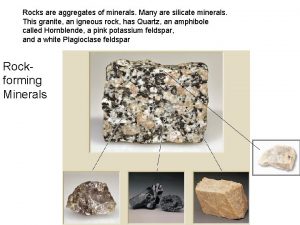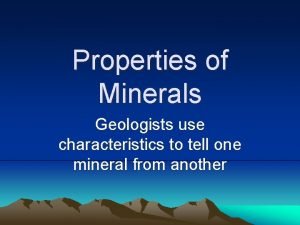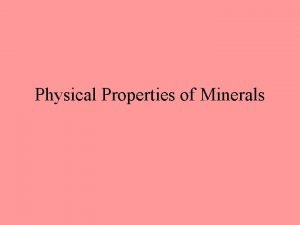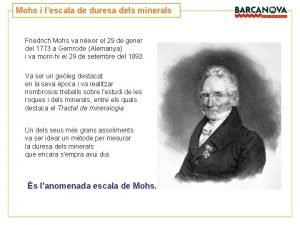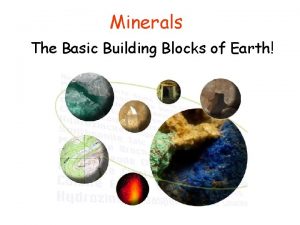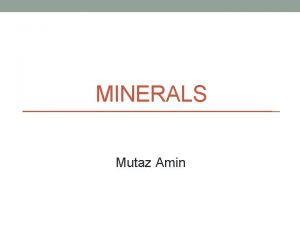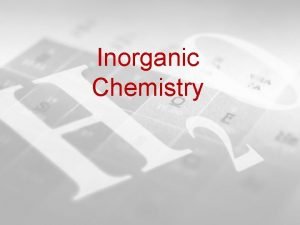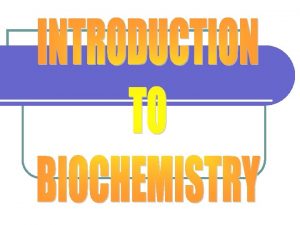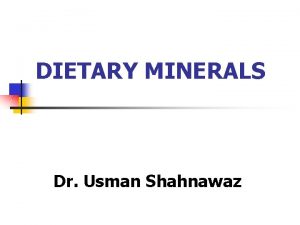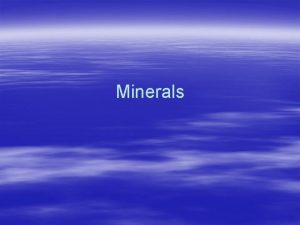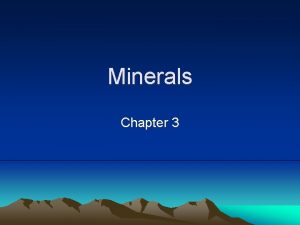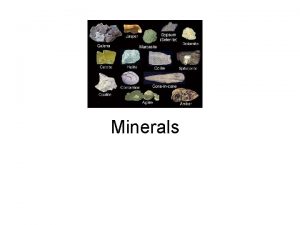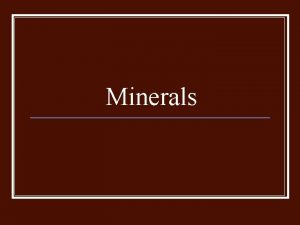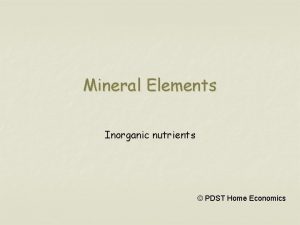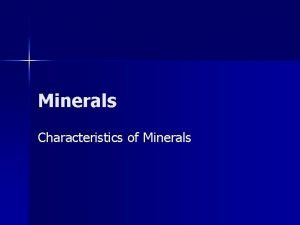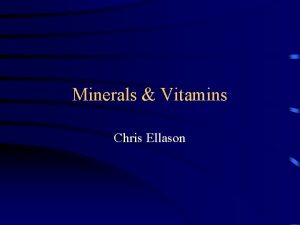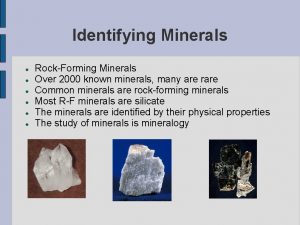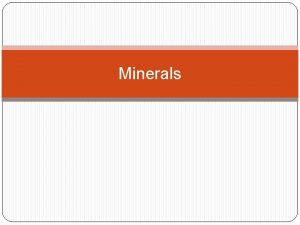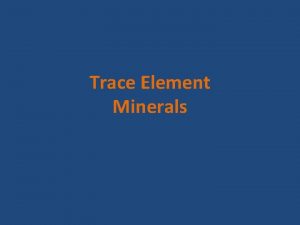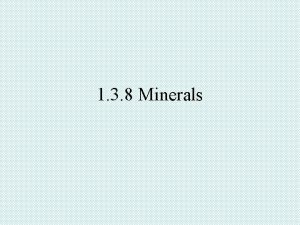Minerals v Minerals are Inorganic elements v Not






















































































- Slides: 86

Minerals v Minerals are Inorganic elements v Not synthesized in human body v Widely distributed in nature v Present in foods of Plant and Animal origin 1

• Minerals in human body have various structural and functional roles • Hence it is essential to ingest Minerals through diet. 2

Human Body Ingests Seven Food Nutrients Dietary Fiber Water Minerals Food Substances Proteins Vitamins Lipids Carbohydrates 3

• Minerals are classified based on: v. Functional need to body v. Its daily requirement 4

Two Broad Classes Of Minerals • Macro elements • Micro/trace elements • Ultra trace element (required in amounts <1 mg/d) 5

• Macro/Principle/Chief elements • Body needs Macro elements relatively in large quantities • present in body tissues at concentrations >50 mg/kg • Requirement of these Minerals is >100 mg/day 6

Macro elements 1. 2. 3. 4. 5. 6. 7. Calcium (Ca) Phosphorus (P) Sulfur (S) Magnesium (Mg) Sodium (Na) Potassium (K) Chloride (Cl) 7

• Micro Minerals /Trace Elements • Body needs Micro Minerals relatively in less amount • Present in body tissues at concentrations <50 mg/kg • Requirement of these Minerals is � 100 mg/day 8

Name Of 10 Essential Micro/Trace Elements 1. Iron (Fe) 2. Copper (Cu) 3. Cobalt (Co) 4. Chromium (Cr) (120 µg/d) 5. Fluoride (F) 6. Iodine (I) (150 µg/d) 7. Manganese (Mn) 8. Molybdenum (Mo) (75 µg/d) 9. Selenium (Se) (35 µg/d) 10. Zinc (Zn) 9

Possibly Essential Elements for Humans (functions not known) Nickel(Ni), Silicon(Si), tin(Sn), Vanadium(V) 10

Toxic elements Arsenic, Lead, Mercury 11

Nutritionally Important Minerals (60 Kg) Macro Minerals Element g/kg Ca P K Na Cl S Mg 15 10 2 1. 6 1. 1 1. 5 0. 4 Trace Elements Element Fe Zn Cu Mo Se I Mn Co mg/kg 20 -50 1 -5 1 -4 1 -2 0. 3 -0. 6 0. 2 -0. 5 0. 02 -0. 1 12

Distribution of Calcium, Phosphate and Magnesium in the Body Tissue Calcium Phosphate Magnesium Skeleton 99% 85% 55% So t tissue 1% 15% 45% Extracellular fluid <0. 2% <0. 1% 1% Total 1000 g (25 mol) 600 g (19. 4 mol) 25 g (1. 0 mol) 13

Equilibria and determinations of calcium in serum. 14

Physiochemical States of Calcium, Phosphate, and Magnesium in Normal Plasma State Calcium Phosphate Magnesium Free (ionized) 50 55 55 Protein-bound 40 10 30 Complexed 10 35 15 Total (mg/d. L) (mmol/L) 8. 6 -10. 3 2. 15 -2. 57 2. 5 -4. 5 0. 81 -1. 45 1. 7 -2. 4 0. 70 -0. 99 Free calcium (mg/d. L) 4. 6 -5. 3 15

Functions of calcium Intracellular calcium 1. Muscle contraction 2. Hormone secretion 3. Second Messenger 4. Glycogen metabolism 5. Cell division 6. Enzyme activation 16

Enzymes regulated by Ca++ Adenyl cyclase Ca++ dependent protein kinases (PKC) Ca++ -Mg++ -ATPase Glycerol-3 -phosphate dehydrogenase Glycogen synthase Myosin kinase Phospholipase C Phosphorylase kinase Pyruvate carboxylase Pyruvate dehydrogenase Pyruvate kinase 17

Functions of calcium Extracellular calcium 1. Bone mineralization 2. Blood coagulation 18

Calcium Dietary Requirements –Adult : 800 mg/day –Pregnancy, lactation and post-menopause: 1500 mg/day –Growing Children: (1 -18 yrs): 1200 mg/day –Infants: (< 1 year): 300 -500 mg /day 19

Dietary Calcium sources - • Rich Calcium Sources Milk and Milk Products Millet (Ragi) Wheat-Soy flour Black strap molasses 20

• Calcium Good sources - Yoghurt, sour cream, ice cream - Tofu - Guava , Figs - Cereals - Egg yolk - Legumes 21

- Green leafy vegetables as collard, kale , Broccolli, Cabbage and raw turnip - Small Fish as trout, salmon and sardines with bones - Meat - Almonds, brazil nuts, dried figs, hazel nuts - Also soybean flour and cottonseed flour 22

• Absorption of Calcium occurs in the Duodenum and proximal Jejunum • Mediated by Calbindin (synthesized by mucosal cells) 23

Factors Promoting Calcium Absorption v Parathyroid Hormone (PTH) indirectly enhances Ca absorption through the increased activation of Calcitriol v. Calcitriol /activated Vitamin D induces the synthesis of Ca binding protein Calbindin v. Acidity Increases the solubility of calcium salts v. Amino acids Lysine and Arginine form soluble complexes with Calcium 24

Factors Inhibiting Calcium Absorption Phytates and Oxalates present in plant origin diet form insoluble salts The high content of dietary Phosphates forms insoluble Ca phosphate Dietary ratio of Ca : P ---1: 1 / 2: 1 is ideal for Ca absorption The Free Fatty acids forms insoluble Ca soaps Alkaline condition Low Estrogen levels Estrogen increases Calcitriol levels High content of Dietary fiber, Caffeine, Sodium Excess Magnesium in diet inhibits Calcium absorption (Magnesium competes with Calcium for absorption) 25

Factors Regulating Blood Calcium Levels • Parathyroid Hormone (PTH) • Vitamin D- Calcitriol • Calcitonin 26

Organs involved for action of PTH Intestine Bone Kidney 27

PTH Action on the Bone Stimulating osteoclastic bone resorption. Indirect effect through local mediators (RANK ligand, tissue growth factor β) →blood Ca level ↑ This Inhibits osteoblast function- Directly by interacting with their PTH receptors 28

Action Of PTH on the Kidney and Intestine Parathyroid hormone acts on distal tubule through a c. AMP dependent mechanism and Increases renal re absorption of Calcium PTH increases phosphate excretion at the proximal tubule by lowering the renal phosphate threshold. Action on the Intestine: indirect PTH is a trophic factor for renal 25(OH)D 1α hydoxilase. Increases conversion of 25(OH)D to the active metabolite 1, 25(OH)2 D increases the intestinal absorption of Ca by promoting the synthesis of Calcitriol. 29

Effect of vitamin D v. Increase calcium binding protein synthesis v. Increase calcium absorption v. Increase phosphate absorption 30

31

Causes of Hypocalcemia Hypoalbuminemia Chronic renal failure Magnesium deficiency Hypoparathyroidism Pseudohypoparathyroidism Osteomalacia and rickets due to vitamin D def. or resis Acute hemorrhagic and edematous pancreatitis Healing phase of bone disease of treated hyperpara and hematological malignancies (hungry bone synd. ) 32

Causes of Hypercalcemia Primary hyperparathyroidism Parathyroid adenoma, hyperplasia, carcinoma Malignancy Skeletal metastases Humoral hypercalcemia PTH-r. P Hematological malignancy Cytokines (interleukin-1, tumor necrosis factor, etc. ) 1, 25 -Dihydroxyvitamin D (lymphoma) Familial hypocalciuric hypercalcemia 33

Causes of Hypercalcemia contd Idiopathic hypercalcemia of infancy Vitamin overdose, vitamin D Granulomatous diseases (e. g. , sarcoidosis, tuberculosis) Renal failure Chronic, acute (diuretic phase) or after transplant Chlorothiazide diuretics Lithium therapy Milk-alkali syndrome Immobilization Increased serum proteins Hemoconcentration, Paraprotein 34

Factors altering the distribution of calcium Factors altering protein binding of calcium Altered concentration of albumin or globulin Heparin p. H Free fatty acids Bilirubin Drugs Temperature Factors altering complex formation Citrate Bicarbonate Lactate Phosphate , Sulphate Anion gap 35

Preanalytical Factors in Measurement of Serum Total or Free Calcium In Vivo Tourniquet use and venous occlusion (protein bound ca Incrd) Changes in posture: increase of total calcium on standing Decrease of total ca on recumbency Exercise (free ca) Hyperventilation (free ca) Fist clenching Alimentary status Alterations in protein binding Alterations in complex formation Prolonged bed rest (both total and free ca increased) 36

Preanalytical Factors in Measurement of Serum Total or Free Calcium contd In Vitro Inappropriate anticoagulants Dilution with liquid heparin Interfering concentrations of heparin Contamination with calcium Corks, glassware, tubes Specimen handling Alterations in p. H ( free calcium) Adsorption or precipitation of calcium Spectrophotometric interference Hemolysis, icterus, lipemia 37

Causes of Hypophosphatemia v Shift of phosphate from extracellular to intracellular space Glucose Insulin Respiratory alkalosis-accelerates glycolisis v Renal phosphate wasting Lowered renal phosphate threshold Primary or secondary hyperparathyroidism Renal tubular defects Familial hypophosphatemia Fanconi syndrome v Decreased net intestinal absorption Increased Loss---Vomiting, Diarrhoea, antacids Decreased absorption Malabsorption Vitamin D deficiency v Intracellular phosphate loss Acidosis Ketoacidosis, Lactic acidosis 38

Clinical manifestation of serum phosphate depletion depend on length and degree of deficiency Plasma conc <1. 5 mg/d. L----produce clinical manifestation Glycolysis impaired Muscle weakness Acute respiratory failure Decreased cardiac output Very low serum phosphate (<1 mg/d. L) Rhabdomyolysis Tissue hypoxia Mental confusion, Coma Serum phosphate concentration <0. 5 mg/d. L Hemolysis of red blood cells 39

Causes of Hyperphosphatemia Decreased renal phosphate excretion Decreased glomerular filtration rate Renal failure Increased tubular reabsorption (increased threshold) Hypoparathyroidism Pseudo hypoparathoidism Acromegaly Increased phosphate intake Oral or intravenous administration Phosphate containing enema Increased extracellular phosphate load Transcellular shift Lactic acidosis, Resp acidosis, DKA Cell lysis Rhabdomyolysis Intravascular hemolysis 40

Magnesium Fourth most abundant cation in the body RBC content of Mg= 3 times of serum Absorbed from distal small bowel Excreted mainly through kidney Daily requirement: 300 -350 mg/d (male) Reference interval 1. 7 -2. 4 mg/d. L Mg is important in neuromuscular excitability Activator of large number of enzymes: Alkaline phosphatase, hexokinase, Adenylyl cyclase, c. AMP dependent kinase, Squalene synthase, Glutamine synthase Required for many cellular transport processes: insulin dependent glucose uptake. 41

Causes of Magnesium deficiency GI disorder Prolonged nasogastric suction Malabsorption syndrome Acute and chronic diarrhoea Protein calori malnutrition Renal loss Chronic parenteral fluid therapy Osmotic diuresis Glucose (DM) Mannitol Metabolic acidosis Urea Starvation, Hypercalcemia ketoacidosis Alcoholism Drugs Diuretics Aminoglycoside 42

Causes of hypermagnesemia Excessive intake Orally (usually in the presence of CRF) Antacid Cathartic Rectally Purgation Parentally Treatment of pregnancy induced HT Treatment of magnesium deficiency Renal failure Chronic usually with administration of magnesium Antacid Cathartic Enema Infusion Acute Rhabdomyolysis Lithium ingestion 43

Distribution of Iron in a 70 -kg Adult Male Transferrin 3 -4 mg Hemoglobin in red blood cells 2500 mg In myoglobin and various enzymes 300 mg In stores (ferritin) 1000 mg Absorption 1 mg/d Losses 1 mg/d In an adult female of similar weight, the amount in stores would generally be less (100 -400 mg) and the losses would be greater (1. 5 -2 mg/d). 44

Nonheme iron transport in enterocytes 45

Absorption of iron 46

The transferrin cycle 47

Recycling of iron in macrophages 48

Schematic representation of the reciprocal relationship between synthesis of ferritin and the transferrin receptor (Tf. R 1). 49

Role of hepcidin in systemic iron regulation 50

Regulation of hepcidin gene expression 51

Changes in Various Laboratory Tests Used to Assess Iron-Deficiency Anemia Parameter Normal Negative Iron Balance Iron-Deficient Erythropoiesis Iron-Deficiency Anemia Serum ferritin (μg/d. L) 50 -200 Decreased <20 Decreased <15 (TIBC) (μg/d. L) 300 -360 Slightly increased >360 Increased >380 Increased >400 Serum iron (μg/d. L) 50 -150 Normal Decreased <50 Decreased <30 Transferrin saturation (%) 30 -50 Normal Decreased <20 Decreased <10 RBC 30 -50 protoporphyrin (μg/d. L) Normal Increase Soluble 4 -9 transferrin receptor (μg/L) Increase RBC morphology Normal Microcytic Hypochromic 52 Normal

Diagnosis of Microcytic Anemia Tests Iron Deficiency Inflammation Thalassemia Sideroblastic Anemia Smear Micro/hypo Normal micro/hypo Micro/hypo with targeting Variable SI (μg/d. L) <30 <50 Normal to high TIBC (μg/d. L) >360 <300 Normal Percent saturation <10 10– 20 30– 80 Ferritin (µg/L) <15 30– 200 50– 300 Hemoglobin pattern Normal Abnormal Normal 53

Zinc Second most abundant trace element in the body The most available dietary sources of zinc : red meat and fish, Germ and whole bran Dietary reference intake Male: 11 mg/d Female: 8 mg/d Infants and young children= need small amount Strict vegetarians= 50% more zinc /d Zinc in human breast milk is efficiently absorbed because of presence of picolinate and citrate. 54

Zinc metabolism 55

Examples of Zinc containing enzymes Cabonic anhydrase Alkaline phosphatase RNA and DNA polymerase Thymidine kinase and carboxy peptidase Alcohol dehydranase 56

Reference interval of zinc A guidance reference interval: 80 -120 µg/d. L Plasma samples are preferred to serum Serum concentration is 5% higher than that of plasma Concentration decreased after food Concentration is higher in the morning 57

Clinical deficiency of zinc Signs and symptoms : Depressed growth with stunting---cereal based diet Increased incidence of infection Diarrhoea Skin lesions Alopecia 58

Acrodermatitits enteropathica Autosomal recessive inborn error Mutation on SLC (solute linked carrier)39 a 4 gene on chromosome 8 q 24. 3 Affects zinc absorption from intestinal mucosa 1. Periorificial dermatitis 2. Alopecia 3. diarrhoea 59

Role of zinc on immune function Increase in the activity of serum thymulin— the thymus specific hormone involved in T cell function Maintain balance develops between Th 1 and Th 2 helper cells Increase the lytic activity of natural killer cells Improve cell mediated immunity 60

Dietary sources of copper Organ meats , liver, kidney Shell fish Whole grain cereals Cocoa containing products Absorption The extent of absorption: 20 -50% Absorption reduced by: Zinc, molybdate, iron Absorption increased by aminoacids 61

Metabolism of copper 62

Functions of Copper In cellular respiration: cytochrome c oxidase-located on mitochondrial membrane Formation and maintenance of myelin : cytochrome c oxidase Iron homeostasis: ceruloplasmin Melanin formation: tyrosinase Neuro transmitter production : Dopamine β-hydroxylase catalyzes the conversion of dopamine to the neurotransmitter norepinephrine MAO- catalyzes the metabolism of seroronin Synthesis of connective tissue: lysyl oxidase- stabilization of extracellular matrix- enzymatic cross linking of collagen and elastin Protection against oxidants: Superoxide dismutase- protects against free radical damage 63

Menkes disease Kinky or steely hair disease X linked , affects only male infants Mutations in the gene ATP 7 A gene for a copper binding P type ATP ase: Responsible for directing the efflux of copper from cells Copper is not mobilized from the intestine—accumulates Activities of enzymes are decreased—because of defect of its incorporation into the apoenzyme Absence of hepatic involvement 64

Wilson disease Mutation in a gene encoding a copper binding P type ATPase Copper fails to be excreted in the bile and accumulates in liver, brain, kidney and RBC Inhibit the coupling of copper to apoceruloplasmin and leads to low level of ceruloplasmin in plasma Hemolytic anemia, chronic liver disease, neurologic syndrome Kayser-Fleisher ring Liver biopsy should be performed Treatment: 65

Major Laboratory tests used in the investigation of diseases of copper metabolism Test Normal adult range Serum copper Ceruloplasmin 10 -22µmol/L (70140µg/d. L) 200 -600 mg/L Urinary copper <1 µmol (60µg)/24 h Liver copper 20 -50 µg/g dry weight 66

Major Laboratory tests used in the investigation of diseases of copper metabolism Test Wilson disease Serum copper <8 µmol/L Ceruloplasmin <200 mg/L Urinary copper >3 µmol/24 h Liver copper >250 µg/g dry weight 67

Copper and Anaemia Interfering iron transport Part of ALA synthase Microcytic hypochromic Iron resistant 68

Selenium is an essential element for humans Constituent of the enzyme glutathione peroxidse The most biologically active compounds contain Selenocysteine: Selenium is substituted for sulphu in cysteine; incorporated into protein by specific codon…. . Ingested selenium compounds include selenate, selenite , selenocysteine, Selenomethionine RDA= 55µg/d 69

Dietary sources and metabolism of Selenium Mainly as selenomethionine from plants Selenium from Inorganic salts are more rapidly incorporated than organic sources 50 -60% of total plasma selenium- selenoprotein P 30%-- GSHPX-3 Rest- into albumin as selenomethionine Major route of excretion: Urine ( 20 -1000µg/L) 70

Metabolic pathways of selenium 71

Functions of Selenium Glutathione Peroxidase Remove an oxygen atom from H 2 O 2 and lipid hydroperoxide 1. GSHPx-1 in red cell s, 2. GSHPx-2 in gastrointestina mucosa, 3. blood plasma GSHPx-3, 4. the cell membrane– located GSHPx-4. Iodothyronine Deiodinase T 4→ T 3 Thioredoxin Reductases Selenoprotein P-transport protein and has antioxidant function 72

Severe Deficiency Keshan Disease. Kashin-Beck Disease Marginal Deficiencies Thyroid Function Immune Function– both cell mediated and B cell function are impair Reproductive Disorders—necessary for testostereone synthesis and maintenance of sperm viability Mood Disorders-anxiety, confusion, hostility Inflammatory Conditions- arthritis, pancreatitis Viral Virulence—Coxackie virus Cancer Chemoprevention 73

Toxicity of Selenium Garlic odor Hair loss Nail damage Reference interval: 63 -160 µg/L Selenium depletion: <40µg/L Tolerable upper limit 400 µg/d Laboratory assessment: CFAAS (Carbon furnace AAS) ICP(inductively coupled plasma)-MS 74

Vitamin E sparing effect of Selenium 75

Fluoride Most widely used pharmacologically beneficial trace elements Supplementation: Water Salt Sugar Milk 76

Function of fluoride The fluoride is exchanged for hydroxil in the crystal structure of apatite, a main component of skeletal bone and teeth. Stabilizes the regenerating tooth surface. To reduce decay of the erupting teeth as well as Topical effect on adult teeth. Pharmacological doses of fluoride may reduce the incidence of bone fracture in patients with osteoporosis. 77

Absorption, transport, metabolism and excretion of Fluoride Absorbed from the stomach and the small intestine Peak increase in blood plasma occurs within 1 hour Ions are rapidly cleared from plasma into tissues In exchange with anion e, g. hydoxil, citrate, carbonate 96% of the 2. 6 g of total body fluoride is located in bones and teeth 90% of excess fluoride is excreted in urine 78

Toxicity of Fluoride Dental fluorosis: The mottling of enamel in the erupting teeth of children A disfiguring condiition Caused by ingestion of fluoride containing toothpaste Skeletal fluorosis: Occupational exposure to inhaled fluoride dust among Cryolite workers during aluminium refining: Bone abnormalities 79

Laboratory assessment of status of Fluoride Analysis of drinking water Determination of fluoride in urine Direct determination using fluoride specific electrode Reference interval of Fluoride Concentration in body fluids and tissue vary widely For urine: a guideline interval is: 0. 2 – 3. 2 mg/L 80

Dental fluorosis 81

Common sources of dietary iodine naturally in soil and seawater Iodized table salt Cheese Cows milk Eggs Frozen Yogurt Ice Cream Iodine-containing multivitamins Saltwater fish Seaweed (including kelp, dulse, nori) Shellfish Soy milk, Soy sauce Yogurt 82

Synthesis o thyroid hormones 83

Deficiency of iodine Hypothyroidism PREGNANCY-RELATED PROBLEMS: miscarriages, stillbirth, preterm delivery, congenital abnormalities in their babies Children of mothers with severe iodine deficiency during pregnancy mental retardation (preventable cause) problems with growth, hearing, and speech Cretinism ( permanent brain damage, mental retardation, deaf mutism, spasticity, ) 84

The recommended average daily intake of iodine Adult: 150 µg/d children: 90– 120 µg/d pregnant women: 200 µg/d Urinary iodine is >10 µg/d. L in iodine-sufficient populations 85

MEDIAN POPULATION URINARY IODINE VALUES AND IODINE NUTRITION MEDIAN URINARY IODINE CONCENTRATION (μg/L) CORRESPONDING IODINE INTAKE (μg/day) IODINE NUTRITION <20 <30 SEVERE DEFICIENCY 20 -49 30 -74 MODERATE DEFICIENCY 50 -99 75 -149 MILD DEFICIENCY 100 -199 150 -299 OPTIMAL 200 -299 300 -449 MORE THAN ADEQUATE >299 >449 POSSIBLE EXCESS 86
 Insidan region jh
Insidan region jh Minerals are inorganic elements that the body
Minerals are inorganic elements that the body Iron deficiency anemia smear
Iron deficiency anemia smear Uncontrolled, lacking in restraint
Uncontrolled, lacking in restraint Minor elements
Minor elements Rock vs mineral
Rock vs mineral Biotitie
Biotitie Elements are moved between minerals during metamorphism by:
Elements are moved between minerals during metamorphism by: Smear layer
Smear layer Organic and inorganic compounds experiment
Organic and inorganic compounds experiment Inorganic plants
Inorganic plants Importance of inorganic chemistry
Importance of inorganic chemistry Inorganic chemistry vs organic chemistry
Inorganic chemistry vs organic chemistry Neon organic or inorganic
Neon organic or inorganic Organic vs inorganic
Organic vs inorganic Organic vs inorganic compounds
Organic vs inorganic compounds Organic molecules vs inorganic molecules
Organic molecules vs inorganic molecules What is inorganic matter
What is inorganic matter A narrow channel or slab of a mineral
A narrow channel or slab of a mineral Organic and inorganic cofactors
Organic and inorganic cofactors Whats the difference between organic and inorganic
Whats the difference between organic and inorganic Inorganic catalyst vs enzyme
Inorganic catalyst vs enzyme Cold cream definition in pharmacy
Cold cream definition in pharmacy Organic and inorganic cofactors
Organic and inorganic cofactors Inorganic catalyst vs enzyme
Inorganic catalyst vs enzyme Organic matrix of bone
Organic matrix of bone Inorganic nomenclature worksheet
Inorganic nomenclature worksheet Inorganic gaseous pollutants of air
Inorganic gaseous pollutants of air Advanced inorganic chemistry lecture notes
Advanced inorganic chemistry lecture notes Inorganic mineral definition
Inorganic mineral definition Which compound is inorganic
Which compound is inorganic Organic vs inorganic compounds
Organic vs inorganic compounds Silicones uses
Silicones uses Inorganic gaseous pollutants of air
Inorganic gaseous pollutants of air Inorganic geology definition
Inorganic geology definition Calculus subgingival
Calculus subgingival Chemical nomenclature flow chart
Chemical nomenclature flow chart Inorganic precipitating agents examples
Inorganic precipitating agents examples Inorganic precipitating agents
Inorganic precipitating agents Organic vs inorganic growth
Organic vs inorganic growth Inorganic growth advantages and disadvantages
Inorganic growth advantages and disadvantages Homogeneous inorganic substances
Homogeneous inorganic substances Inert pair effect
Inert pair effect Inorganic non metallic materials examples
Inorganic non metallic materials examples Inorganic nomenclature flow chart
Inorganic nomenclature flow chart Organic and inorganic nutrients
Organic and inorganic nutrients Oxalic acid is organic or inorganic
Oxalic acid is organic or inorganic Conclusion of anemia ppt
Conclusion of anemia ppt Mnvii
Mnvii Inorganic nomenclature
Inorganic nomenclature Hsab chemistry
Hsab chemistry What is enzymes
What is enzymes Inorganic pollution
Inorganic pollution Organic vs inorganic
Organic vs inorganic Cons of pesticides
Cons of pesticides Naturally occurring inorganic solid material
Naturally occurring inorganic solid material Organic vs inorganic
Organic vs inorganic If you're not confused you're not paying attention
If you're not confused you're not paying attention Informal casual
Informal casual Attention is not not explanation
Attention is not not explanation Being too broad
Being too broad If p then q
If p then q Just about right scale
Just about right scale Love is not all imagery
Love is not all imagery Ears that hear and eyes that see
Ears that hear and eyes that see P ran
P ran If you cant measure it you can't manage it quote
If you cant measure it you can't manage it quote We will not be shaken we will not be moved
We will not be shaken we will not be moved Not a rustling leaf, not a bird in flight
Not a rustling leaf, not a bird in flight You can not not communicate
You can not not communicate Elements of theatre
Elements of theatre Overhead allocation
Overhead allocation Hydrosulfuric acid
Hydrosulfuric acid Http //elements.wlonk.com/elements table.htm
Http //elements.wlonk.com/elements table.htm Elements of a folk tale
Elements of a folk tale Features of a folktale
Features of a folktale Streak of minerals
Streak of minerals Conflict minerals
Conflict minerals Storage of minerals
Storage of minerals Ravine erosion
Ravine erosion Rocks are aggregates of minerals
Rocks are aggregates of minerals Song about igneous rocks
Song about igneous rocks Rocks
Rocks What does cleavage mean in minerals
What does cleavage mean in minerals Color properties of minerals
Color properties of minerals Escala de mohs catala
Escala de mohs catala Luster
Luster

